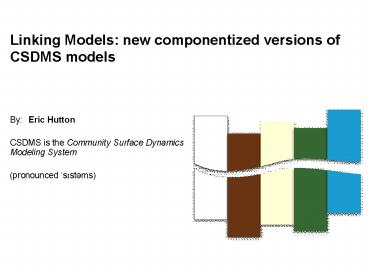Linking Models: new componentized versions of CSDMS models - PowerPoint PPT Presentation
1 / 23
Title:
Linking Models: new componentized versions of CSDMS models
Description:
No command line interface. No input files ... Command line interface. GUI (within CCA) CCA component. Output format ... input file, and command line ... – PowerPoint PPT presentation
Number of Views:34
Avg rating:3.0/5.0
Title: Linking Models: new componentized versions of CSDMS models
1
Linking Models new componentized versions of
CSDMS models
- By Eric Hutton
- CSDMS is the Community Surface Dynamics Modeling
System - (pronounced 's?st?ms)
2
Some proof of concept projects that are underway
3
Some proof of concept projects that are underway
Murray Coastal Evolution Model
HydroTrend
sedflux
Child
TopoFlow
GC2D
4
These models reflect the wide range of models in
our community
- These 6 models represent
- 6 authors
- 4 languages
- 4 domains
- 140,000 lines of source code
- of a total of 215,000 in our repository
- 3 different grids
- raster, non-uniform mesh, spatially averaged
- 2 different levels of model granularity
- process and model
5
A standalone model is componentized by dividing
it into bits that perform tasks that other
components can use
Initial Standalone Model
6
HydroTrend predicts the flux of water and
sediment at a river mouth
Precipitation
HydroTrend
Snow Fall/Melt
Rain Fall
Evaporation/Evapotranspiration
7
HydroTrend predicts the flux of water and
sediment at a river mouth
- HydroTrend
- 10,500 lines of C code
- Minimal command line interface
- Input precipitation statistics
- Output river discharge as binary hydrotrend file
8
HydroTrend still predicts the flux of water and
sediment at a river mouth
- HydroTrend
- 11,300 lines of C code (8 increase mostly new
files) - API (IRF, and getters and setters)
- Expanded CLI
- GUI (within CCA)
- CCA component
Checkout a version from our model repository gt
svn checkout https//csdms.colorado.edu/svn/hydrot
rend
9
CEM predicts the distribution of sediment after
it enters the ocean
Coastal Evolution Model
Sediment Distribution
10
CEM predicts the distribution of sediment after
it enters the ocean
- CEM
- 4,300 lines of C code
- No command line interface
- No input files (hardcoded variables)
- Constant sediment supply, wave angle
characteristics - Output bathymetry as text file
11
CEM still predicts the distribution of sediment
after it enters the ocean
- CEM after
- 4,500 lines of C code (8 increase mostly new
files) - API (IRF, and getters/setters) C, and Python
- Library
- Command line interface
- GUI (within CCA)
- CCA component
- Output format CSV, BOV, netcdf
Checkout a version from our model repository gt
svn checkout https//csdms.colorado.edu/svn/deltas
12
Child is a landscape evolution model that
delivers sediment to the ocean
- Child details
- 39,000 lines of C code
- Component model
- User interface through input file
- Lots of output variables as ASCII files
- Calculations done on a non-uniform mesh
13
As the land rises, water erodes the landscape and
carries sediment to the ocean where its dumped
14
sedflux links component models to simulate the
growth of a continental margin.
15
sedflux provides a framework that keeps track of
stratigraphy
- sedflux details
- 70,000 lines of C code
- Component model
- User interface through input file, and command
line - Lots of output variables as confusing binary data
- Calculations done on a uniform mesh
16
Child does its calculations on an unstructured
mesh
17
Sedflux, like most of our models, uses a uniform
mesh
18
Mapping from a Child grid to a sedflux grid with
similar resolution
19
Mapping from a Child grid to a sedflux grid with
a coarser resolution
20
Both Child and sedflux are components but they
have not been linked quite yet
- As with our other components, both models
- Have an API (and so a library)
- Can be run by CSDMS members remotely on beach
- Can be run as a standalone model or as a
component - Can be linked to other components (in other
languages)
21
The CSDMS Modeling tool allows users to link
models through a graphical interface
Using this GUI, they can choose components from
available palettes to create their own,
customized applications, and then run them on our
cluster. We have linked our GUI with VisIt to
provide run-time visualization.
22
Process components seem to be the most natural
level of granularity for model componentization.
Processes (such as infiltration) represent the
scale at which modelers are most likely to want
to replace one approach with another. For
example, modelers very often want to compare
different approaches and algorithms with respect
to speed, accuracy, scalability or realism.
VS
23
Lost in translation
Converting models from one language to another is
a complex task that should be avoided whenever
possible. Conversion tools usually cannot fully
automate the conversion process.
24
In conclusion,
Questions?































